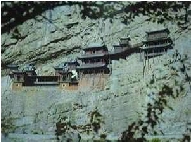|
 Datong
and around Donít be put
off by first impressions
of contemporary DATONG,
the second largest city
in Shanxi Province,
situated in the far
north, near the border
with Inner Mongolia.
Amid the blasted
landscape of modern
industrial
China-coalmines, power
stations and a huge
locomotive factory--are
some marvellous ancient
sites, remnants of the
cityís glory days as the
capital city of two
non-Han Chinese
dynasties. The Turkic
Toba people took
advantage of the
internal strife
afflicting central and
southern China to
establish their own
dynasty, the Northern
Wei(386-534), taking
Datong as their capital
in 398 AD, by which time
they had conquered the
whole of the north.
Though the period was
one of strife and
warfare, and the Wei
never fully consolidated
their hold on power, the
Northern Wei, who became
fervent Buddhists, made
some notable cultural
achievements, the finest
of which was a
magnificent series of
cave temples at Yungang,
just west of the city,
still one of the most
impressive sights in
northern China. Over the
course of almost a
century, more than fifty
caves were completed,
containing over fifty
thousand statues, before
the capital was moved
south to Luoyang, where
contruction began on the
similar Longmen Caves. A
second period of
greatness came with the
arrival of the Mongol
Liao dynasty, also
Buddhists, who made
Datong their capital in
907. They were
assimilated into the Jin
in 1125, but not before
leaving a small legacy
of statuary and some
fine temple
architecture, notably in
the Huayan and Shanhua
temples in town, and a
wooden pagoda, the
oldest in China, in the
nearby town of Yingxian.
Datong remained
important to later
Chinese dynasties for
its strategic position
just inside the Great
Wall, south of Inner
Mongolia, and the tall
city walls date from the
early Ming dynasty.
Though most visitors
today are attracted by
the Buddhist sites,
Datong is also the
closest city to Heng
Shan, one of the five
holy mountains of
Taoism, whose most
spectacular building,
the almost unbelievable
Hanging Temple, is
firmly on the tour
agenda. Datong
and around Donít be put
off by first impressions
of contemporary DATONG,
the second largest city
in Shanxi Province,
situated in the far
north, near the border
with Inner Mongolia.
Amid the blasted
landscape of modern
industrial
China-coalmines, power
stations and a huge
locomotive factory--are
some marvellous ancient
sites, remnants of the
cityís glory days as the
capital city of two
non-Han Chinese
dynasties. The Turkic
Toba people took
advantage of the
internal strife
afflicting central and
southern China to
establish their own
dynasty, the Northern
Wei(386-534), taking
Datong as their capital
in 398 AD, by which time
they had conquered the
whole of the north.
Though the period was
one of strife and
warfare, and the Wei
never fully consolidated
their hold on power, the
Northern Wei, who became
fervent Buddhists, made
some notable cultural
achievements, the finest
of which was a
magnificent series of
cave temples at Yungang,
just west of the city,
still one of the most
impressive sights in
northern China. Over the
course of almost a
century, more than fifty
caves were completed,
containing over fifty
thousand statues, before
the capital was moved
south to Luoyang, where
contruction began on the
similar Longmen Caves. A
second period of
greatness came with the
arrival of the Mongol
Liao dynasty, also
Buddhists, who made
Datong their capital in
907. They were
assimilated into the Jin
in 1125, but not before
leaving a small legacy
of statuary and some
fine temple
architecture, notably in
the Huayan and Shanhua
temples in town, and a
wooden pagoda, the
oldest in China, in the
nearby town of Yingxian.
Datong remained
important to later
Chinese dynasties for
its strategic position
just inside the Great
Wall, south of Inner
Mongolia, and the tall
city walls date from the
early Ming dynasty.
Though most visitors
today are attracted by
the Buddhist sites,
Datong is also the
closest city to Heng
Shan, one of the five
holy mountains of
Taoism, whose most
spectacular building,
the almost unbelievable
Hanging Temple, is
firmly on the tour
agenda. |



